Wondering how to know if a dog has fleas? If so, you’ve come to the right place. Integrative veterinarian Dr. Julie Buzby discusses the signs a dog has fleas and explains several methods that can help you tell if your dog has fleas. Plus, she gives you an overview of how to control fleas on your dog and in the environment.
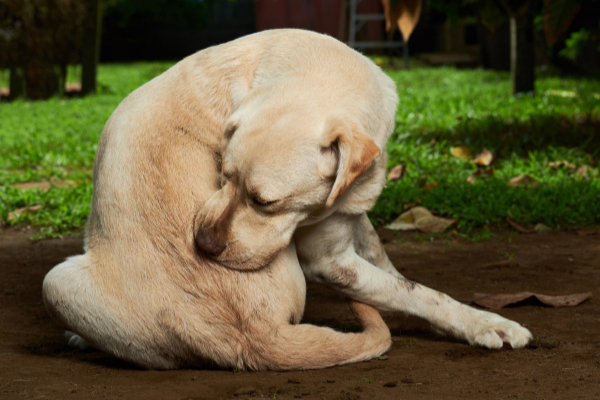
Fleas…does the very thought of these tiny brown blood-sucking parasites make your skin crawl? Fleas sure make your dog’s skin crawl, as well as itch or become inflamed. So as a dog parent, it is important to understand how to tell if a dog has fleas.
How do you know if a dog has fleas?
Figuring out if your dog has fleas requires a combination of looking for the symptoms of fleas and looking for evidence of the fleas themselves.
Watching for the signs a dog has fleas
Some dogs are going to be more bothered by fleas than others. The extent to which you see signs of fleas will depend on how many fleas the dog has and how sensitive the dog is to flea saliva.
When a flea bites your dog, components of the flea saliva stimulate an inflammatory response. And in some cases, the dog is actually allergic to flea saliva (a condition called flea allergy dermatitis or FAD). Dogs with FAD or those who are highly sensitive to flea saliva are much more likely to show the symptoms discussed below, even if they don’t have a large number of fleas.
But dogs who aren’t very sensitive to flea saliva or have a small number of fleas may show minimal symptoms or no symptoms at all.
So you can’t rely on symptoms alone as a way to know if your dog has fleas.
Symptoms of fleas in dogs
If a dog does show symptoms of fleas, they may include:
- Scratching and itching—Flea bites can cause itching and discomfort for your dog. Scratching will be worse where there are more fleas. Common areas include the ears, neck, base of the tail, and groin region.
- Scabbing or redness—Your dog’s skin may turn red or be hot to the touch. And you may notice scabs or sores.
- Biting or chewing at the skin—Since your dog is itchy, he or she may be excessively licking or chewing on the legs, tail, or other areas of the skin.
- Hair loss—The dog’s fur may be thinner or missing completely in areas. For example, fleas can cause hair loss on a dog’s tail and rump.
- Skin problems—Dry flaky skin, red irritated skin, hot spots in dogs, or pyoderma in dogs (i.e. bacterial skin infection) can accompany a flea infestation on a dog.
- Painful skin—Your dog may act uncomfortable when you touch certain areas of his or her body.
- Adult fleas or flea dirt— You may be able to see fleas or dark brown flea dirt (i.e. flea feces) when you part your dog’s hair or use a flea comb. More on this below.
- Tapeworms segments near your dog’s anus—Fleas can be carriers of tapeworms. So you might see small tapeworm segments that look like a grain of rice near your dog’s anus or hind end.
- Pale gums—In dogs with severe infestations, the fleas may suck enough blood to cause anemia in dogs (i.e. low red blood cell numbers). Pale gums are the most common sign of anemia.
- Agitation—When your dog is extremely itchy, he or she may seem more on edge. Or your dog might have difficulty settling down to rest.
Remember that other conditions can have the same symptoms
However, it is important to mention that these symptoms don’t specifically point to the dog having fleas. Other conditions such as food or seasonal allergies, skin infections, or mites (demodex or scabies) can also cause some of these signs such as itching, hair loss, and red irritated skin.
Sure-fire methods for finding fleas or flea dirt on your dog
Thus, the other part of figuring out if your dog has fleas is knowing how to find the fleas or flea dirt. There are several good ways to do this.
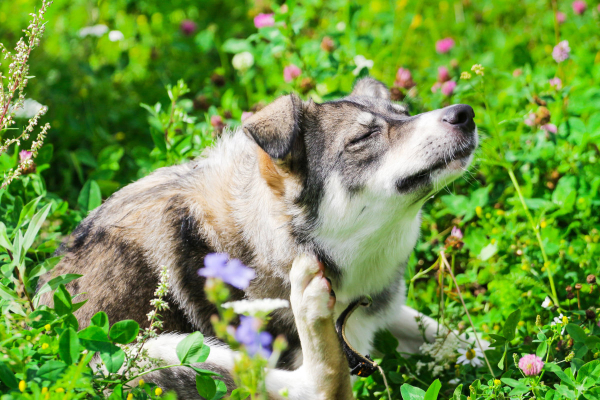
Part your dog’s hair and look for fleas or flea dirt
Fleas are tiny, but it is possible to see them with the naked eye. They look like tiny shiny brown jumping bugs.
Some of the best places to spot fleas on your dog are:
- On the face near the nose or eyes
- In the neck area around the collar
- Along the back and near the base of the tail
- On the abdomen close to the groin area
Gently part the fur in each of these locations until you can see all the way down to the skin. You may see fleas in the fur or directly on the skin. Or the skin may look like it is “crawling” or moving. This can indicate that many fleas are present.
Additionally, you can look for flea dirt as you part your dog’s hair. Flea dirt is flea poop that is left behind after a flea feeds. On your dog it looks like specs of dirt or black pepper. And since it contains digested blood, it will give off a reddish color when it gets wet.
It is easier to see fleas or flea dirt on dogs with thin coats and/or light colored fur. Dark or thick fur can hide fleas much more easily. So if you don’t see fleas or flea dirt on visual inspection but are still suspicious, grab a flea comb.
Use a flea comb
Additionally, you can check your dog for fleas using a flea comb. This special fine-toothed comb does a good job of picking up fleas or flea dirt. And by combing a large area of fur at once, you can cover a bigger spot in less time than it would take you to part all the hair.
Once you brush an area of your dog’s fur with the flea comb, simply inspect the comb for fleas or flea dirt.
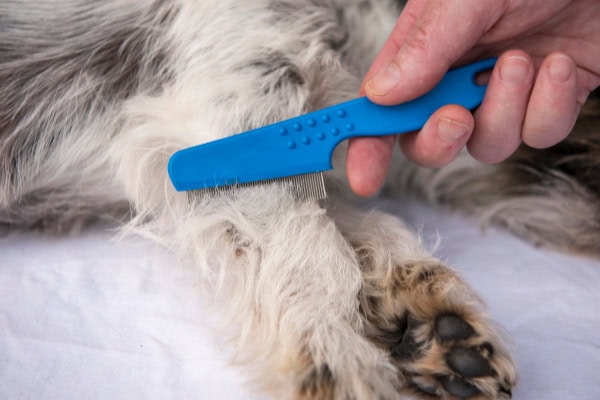
Use a wet white paper towel
Sometimes it can be difficult to know if you’ve found flea dirt versus “regular” dirt. If you aren’t sure, grab a white paper towel and slightly dampen it with water. Then place the suspected flea dirt on the paper towel and gently squish or rub it. If it makes a reddish brown smear like old blood on the paper towel, then it is likely flea dirt. But if it is more brown or black in color, then you probably just found a fleck of real dirt.
Fleas tend to give themselves away by trying to move or jump when you grab them. But if you aren’t sure if you have discovered a flea or dirt, you can also use the technique described above. (You may need to crush the flea with the back of your fingernail rather than the pad of your finger.) A squished flea will leave a smear of brownish or reddish blood on the paper towel.
Other ways to tell if your dog has fleas
In addition to checking your dog for fleas and monitoring for flea symptoms, there are a few other ways to help you know if your dog has fleas.
- Other dogs (or animals) in your house start itching or showing other symptoms of fleas—It is more likely that both animals have fleas than both animals have developed allergies, mites, or a skin infection at the same time.
- You are noticing flea bites on yourself—Fleas prefer to bite your pets. But if your dog has fleas, you may get some flea bites too. Usually they appear on the lower leg near the ankles. And they are more common if your dog sleeps in your bed and has fleas.
- Your dog recently visited a location where fleas are likely to hang out—A recent trip to the dog park, a friend’s house with a known flea problem, or a place where fleas tend to be more prevalent may increase your suspicion that your dog has fleas. However, before you place blame, remember that plenty of other problems can also cause your dog to start itching.
Visit the vet
If your dog is itching or having skin problems and you don’t know why, the best thing you can do is take your dog to the vet. Not only can the vet look for fleas or flea dirt on your dog, but he or she can also perform diagnostics to rule out other similar-appearing skin conditions. Plus, your vet can help you treat the fleas, decrease your dog’s itchiness level, and manage any secondary complications.
For the same reasons, the best thing you can do if you know your dog has fleas is to visit the vet. This is especially true if your dog has any skin problems accompanying the flea infestation or if you don’t already have the appropriate veterinarian-prescribed products to treat the fleas.
How do you get rid of fleas?
Dealing with a flea problem often requires a two-pronged approach. You need to get rid of the adult fleas on your dog and every other animal in the house. But you also need to get rid of the flea life stages in the environment. Otherwise, it may be very challenging to get the fleas under control.
Treat the fleas on your dog
Your veterinarian can help recommend the flea product that is right for your dog. The great news is that there are so many different options for flea prevention and treatment.
You can choose between a topical product, a chewable product, or even a veterinarian-approved flea collar (Seresto® flea and tick collar)—not to be confused with the over-the-counter flea collars, which are not effective or recommended. There are products that just kill fleas and ones that also target ticks, intestinal parasites, or heartworms. Some last for a day, others for a month, and others for several months.
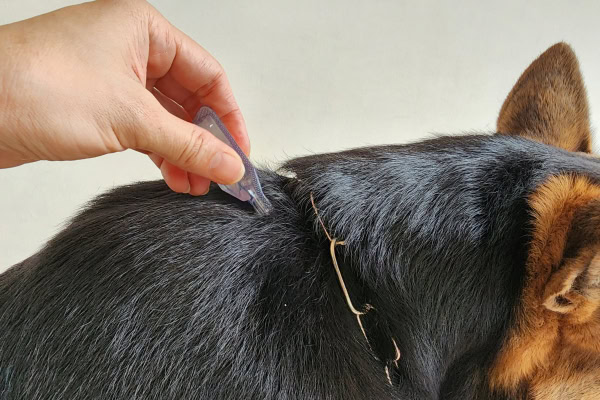
To learn more about the various products, check out this flea and tick prevention chart for dogs from Veterinary Partner.
Important safety note: Purchasing a prescription flea preventive directly from your veterinarian is the best way to ensure the product is safe for your dog, effective, and the real deal. It is not a good idea to use over-the-counter flea products from the pet store. They may be ineffective, or worse yet, dangerous for your dog.
Treat fleas on other animals in the household
In addition to treating your dog for fleas, you will need to treat all other pets in the household. Otherwise they will continue to harbor fleas. And it will be difficult, if not impossible, to get the flea problem under control. Your vet can help you select the flea products that are right for each pet.
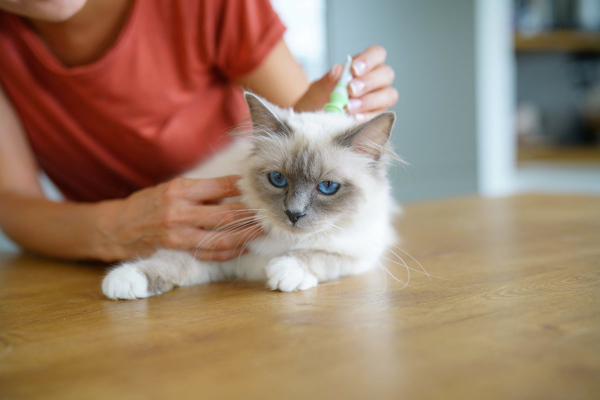
Use flea treatment for an appropriate length of time
Generally, you will need to treat every pet in the household for at least three to four months. But sometimes it takes even longer to fully get rid of the fleas. This is the case because the adult fleas you see on your dog are only 5% of the total population of flea life stages in your home. The other 95% of the flea population is in the egg, larvae, or pupae stage in the environment.
So as these immature fleas develop into adults, they will hop on your dog. If your dog is on an effective flea preventive that kills adult fleas, then the newly emerged adult fleas will die too. But if you stop using the flea preventive while there are still flea life stages in the environment, those new fleas will take up residence on your pets. And the problem will continue.
Treat the environment
Since the vast majority of the flea life stages are in the environment, it is also important to do what you can to decrease those numbers. Some environmental flea control tips include:
- Vacuum the floor and couch (if your dog gets on the couch) daily to pick up adult fleas, flea eggs, and larvae. Then throw the vacuum bag away outside or dump the canister outside each time. If you don’t empty the bag/canister or if you dump it inside instead, the fleas can get out and continue to live in your house.
- At least weekly, wash in hot water your dog’s bedding, your bedding if your dog sleeps with you, and any rugs your dog lays on. Then dry them on high heat or lay them out in the sun to dry. If your dog’s bed doesn’t have a removable washable cover, consider getting a new bed that does. This washing routine is important because all those places where your dog spends a lot of time are hot beds of flea activity.
- Ask a pest treatment company to treat your home and/or yard for fleas
- Use an environmental flea spray or flea foggers in your home to get rid of fleas. Ensure you read the directions carefully and take all necessary precautions to keep yourself and your pets safe.
Depending on how bad the flea infestation is, you may or may not need to use all of these environmental control measures. Your veterinarian can help you determine what is right for your situation.
An ounce of (flea) prevention is worth a pound of cure
It’s important to understand how to know if your dog has fleas and work with your vet to make a plan to get rid of them—and keep them away too! Putting a flea prevention plan in place now (and including it in your dog’s tip-to-tail wellness scan), rather than waiting until the next flea problem arises is so much easier (and better for your dog).
Please speak with your vet about what product and approach is right for your dog. Many dogs need year-round protection using a veterinarian-recommended flea preventive. However, the exact prevention approach can vary depending on the geographic area where you live, your dog’s sensitivity to fleas, and your dog’s specific situation.
By taking a proactive approach to flea prevention, you hopefully won’t have to be searching “how to know if a dog has fleas” in the future. And your dog can enjoy being flea-free.
How did you know your dog had fleas?
Please comment below


Our wonderful groomer of ten-plus years found one flea on each of our two little Havanese. We confirmed with our veterinarian and now have them both on year-round oral flea medicine, which comes in treat form. We call it our “flea tax” to live next door to a wildlife refuge, where foxes and rabbits and occasional coyotes visit our streets–and deer and bison roam on the other side of the fence.
Hi Peggy,
I’m glad your dogs have their oral flea preventative now to pay the “flea tax.” 😊 Living next to the wildlife refuge sounds pretty amazing to me! Hope you and your precious pups continue to enjoy living life to the fullest!